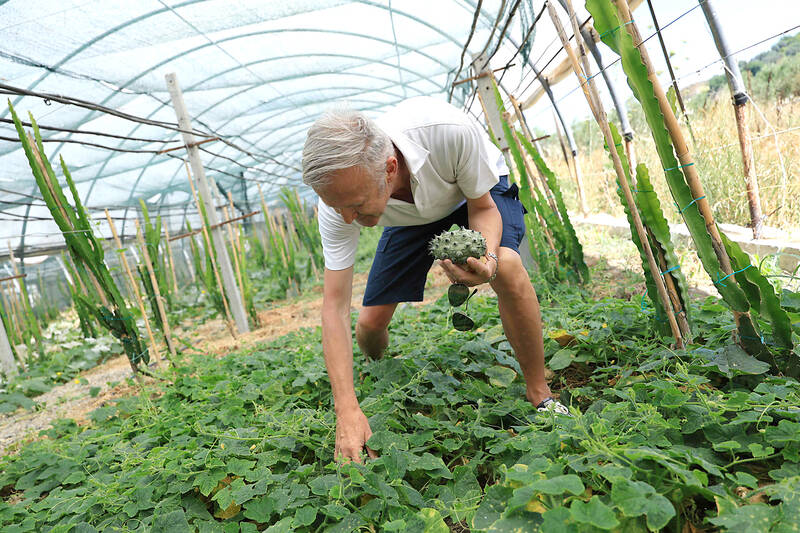Passion fruit, guava, dragon fruit or kiwano — climate change is sparking Albanian farmers to start growing exotic fruits to sell to Europe.
Veteran agronomist Irakli Shkoza’s small farm not far from sea in central Albania is a kind of Garden of Eden in the Adriatic sun.
With temperatures rising every year, Shkoza hit upon the idea to diversify back in 2019 at a time in his life when others would already have been long retired.

Photo: AFP
The 75-year-old first brought seeds from Africa and America and planted them on his two-hectare plot.
All plants have adapted very well to the warm local climate.
Nestled between rolling farmland and the sea, the Divjake region was the granary of Albania, with farmers there now growing vegetables and watermelons for local and export markets.
However, rising temperatures and a worker shortage — the small Balkan nation of 2.7 million has lost 400,000 people in a decade — have taken their toll on farms.
“Exotic fruits need less water and maintenance which makes production costs lower,” Shkoza said.
Albania’s typical Mediterranean climate, with hot, dry summers and mild winters, has changed due to global warming.
By the end of the century, average temperatures in the Western Balkans are projected to rise between 3.5°C and 8.8°C, based on a 2022 study, assuming moderate to high greenhouse gas emissions continue.
Heatwaves “will probably damage crop yields, particularly in Albania, where average temperatures are highest during the summer,” according to researchers Daniel Muller and Max Hofmann from the Leibniz Institute of Agricultural Development in Transition Economies.
Agriculture, forestry and fishing accounted for 19 percent of Albania’s gross domestic product in 2020.
However, climate change need not be completely disastrous, Shkoza said, if we adapt to take advantage of it.
Albanian farmers need to start producing a lot of exotic fruit crops to profit from their favorable climate, he said.
“These fruits are very much in demand on the European market, but they come from far away; Latin America, Southeast Asia, New Zealand, Australia,” he said.
Their transport to Europe has a cost, both financially and in terms of freshness.
If they came from Albania, not only would they be cheaper, they would be fresher, agronomist Altin Hila said.
The papayas found on European markets are harvested while still green and then brought to Europe where they ripen artificially, said Vasil Nikolovski, a production manager from North Macedonia who has been working in Divjake for several years.
“Here, they can ripen on the trees,” he added.
“Albania has the capacity to meet European market demands and with exotic fruits exports and could make a turnover of 100 to 200 million euros annually,” he said.
Shkoza is already exporting dragon fruit, passion fruit and pepinos, or melon pears — which originate in Latin America — to European markets.
With other farmers in the Divjake region, he recently sent 30 tonnes of kiwano, also known as the African horned cucumber, to buyers in Croatia.
“And this year’s harvest looks set to be abundant,” he said, looking at the buds on his dragon fruit flowers.
Some 55km to the west near Elbasan, Lulzim Bullari has started growing kiwis.
“We cannot complain about the high temperatures, the last two years kiwi production has been a blessing,” he said while standing in the middle of his 40 hectares of orchards.
The kiwis he grows are almost exclusively for export to Switzerland and the Netherlands.
Recently, Bullari has also started growing fig trees from North Africa, which are highly resistant to the mild winter climate, on about 15 hectares.
“Luck favors the bold, and you have to run to catch it,” Bullari said.

Taiwan Semiconductor Manufacturing Co (TSMC, 台積電) has secured three construction permits for its plan to build a state-of-the-art A14 wafer fab in Taichung, and is likely to start construction soon, the Central Taiwan Science Park Bureau said yesterday. Speaking with CNA, Wang Chun-chieh (王俊傑), deputy director general of the science park bureau, said the world’s largest contract chipmaker has received three construction permits — one to build a fab to roll out sophisticated chips, another to build a central utility plant to provide water and electricity for the facility and the other to build three office buildings. With the three permits, TSMC

The DBS Foundation yesterday announced the launch of two flagship programs, “Silver Motion” and “Happier Caregiver, Healthier Seniors,” in partnership with CCILU Ltd, Hondao Senior Citizens’ Welfare Foundation and the Garden of Hope Foundation to help Taiwan face the challenges of a rapidly aging population. The foundation said it would invest S$4.91 million (US$3.8 million) over three years to foster inclusion and resilience in an aging society. “Aging may bring challenges, but it also brings opportunities. With many Asian markets rapidly becoming super-aged, the DBS Foundation is working with a regional ecosystem of like-minded partners across the private, public and people sectors

RUN IT BACK: A succesful first project working with hyperscalers to design chips encouraged MediaTek to start a second project, aiming to hit stride in 2028 MediaTek Inc (聯發科), the world’s biggest smartphone chip supplier, yesterday said it is engaging a second hyperscaler to help design artificial intelligence (AI) accelerators used in data centers following a similar project expected to generate revenue streams soon. The first AI accelerator project is to bring in US$1 billion revenue next year and several billion US dollars more in 2027, MediaTek chief executive officer Rick Tsai (蔡力行) told a virtual investor conference yesterday. The second AI accelerator project is expected to contribute to revenue beginning in 2028, Tsai said. MediaTek yesterday raised its revenue forecast for the global AI accelerator used

BREAKTHROUGH TECH: Powertech expects its fan-out PLP system to become mainstream, saying it can offer three-times greater production throughput Chip packaging service provider Powertech Technology Inc (力成科技) plans to more than double its capital expenditures next year to more than NT$40 billion (US$1.31 billion) as demand for its new panel-level packaging (PLP) technology, primarily used in chips for artificial intelligence (AI) applications, has greatly exceeded what it can supply. A significant portion of the budget, about US$1 billion, would be earmarked for fan-out PLP technology, Powertech told investors yesterday. Its heavy investment in fan-out PLP technology over the past 10 years is expected to bear fruit in 2027 after the technology enters volume production, it said, adding that the tech would